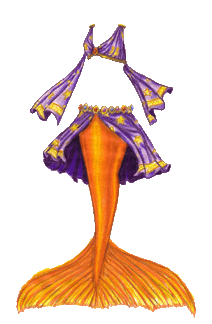 Click for larger version; click for the list of dolls.
Click for larger version; click for the list of dolls.
It’s been such a long time since Mermaid Monday, how very cruel of me… in penance, I’ll reveal some more of their world.
I often think about how, in my paperdollverse, the mermaids interact with the humans, but that is because I myself happen to be human and have that particular bias. Frankly, the majority of mermaids don’t give it as much thought as I do. I’ve come to think of mermaid excursions to the human world as something like American college kids studying abroad. Not everyone is going to be interested in the first place, and some might like to but have other priorities under the seas. Of the ones who do, most might spend only a season of their life exploring the new culture, some might enter into it to some extent but always consider themselves mermaids first and foremost, and a minority, like my bitter crimson mermaid, become permanent expats. Generally, mermaids consider themselves slightly superior to humans, and for the most part there aren’t oodles of mermaids longing to escape to land and legs.
My mom wondered how the switch between tails and legs is actually affected. There are mermaid mystics, with varying amounts of experience and power, who can control such things for a price. Surely we’re all now thinking of Ariel sacrificing her voice? It’s not often so serious; curious young mermaids attending their first human balls usually do so on wobbly legs not shaped quite right (which is why most mermaids favor long ballgowns), thanks to a friend’s crazy old grandmother who will perform the necessary magic for a string of pearls. (The accompanying rite of passage is for excitable mermaids to forget how long the magic lasts and transform back right there on the dance floor. If the girl is lucky, her gallant dance partner will help her back into the water; if she’s not so lucky a couple of already overworked servants will do it, talking maliciously about seared mermaid fillets with lemon sauce over a bed of wild rice.) The longer the magic lasts, the more skillfully the legs are formed and the more control the mermaid has over switching back and forth, the more it will cost. At a certain point, a desperate mermaid switches from grandmothers paid off with pearls to dangerous creatures who demand voices, lifespans, firstborn children and so on. Today’s mermaid is one of these mystics, exceptionally long-lived because she’s always happy to trade legs or looks and so on for a portion of the petitioner’s lifespan. (She isn’t at all ashamed about the price she asks: the study of mermaid mysticism is dangerous, and she sees it as a fair deal given the years she’s devoted to her craft and the scarcity of competitors.) In the face of her present problems, your average impetuous young mermaid couldn’t care less about five or ten years that come off the end of her life anyways. Between the sharks, nets and mystics offering one’s heart’s desire with a price to be paid much later, it is only very smart mermaids who live to be old.
 Share
Share